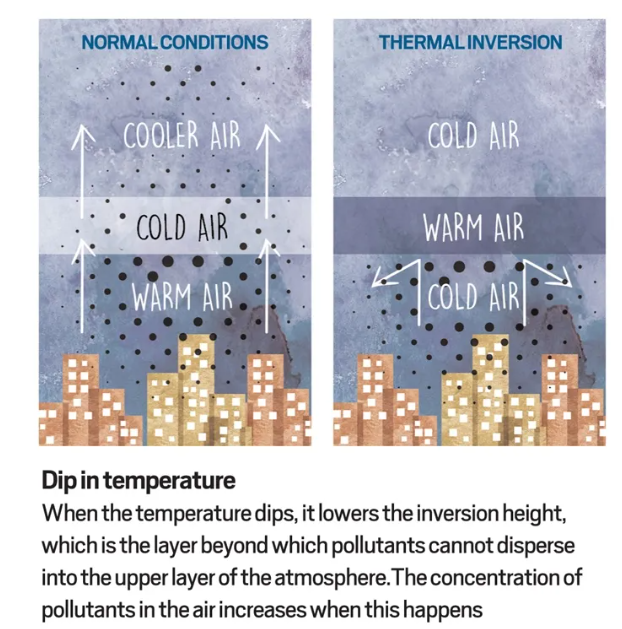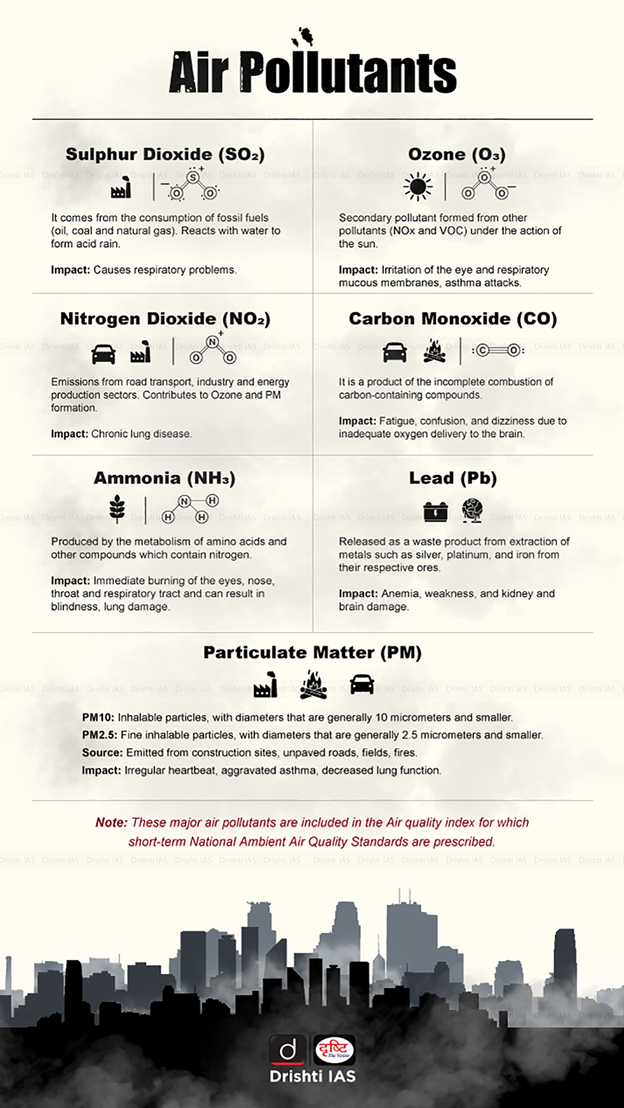Biodiversity & Environment
Delhi’s Winter Plan to Curb Air Pollution
- 16 Sep 2024
- 11 min read
For Prelims: Air pollution, Delhi Pollution Control Committee (DPCC), Municipal Corporation of Delhi (MCD), PM2.5 emissions, ground-level ozone (O3) Pollution, SAFAR, Stubble burning, Volatile Organic Compounds (VOC), Smog, Ultraviolet (UV) Radiation.
For Mains: Main Causes of Air Pollution in Delhi during Winters, Critically examine the impact of Ground-Level Ozone in Delhi.
Why in News?
Recently, the Delhi government launched a 21-point winter action plan to combat air pollution, featuring real-time drone surveys and a special task force.
What Does Delhi's Winter Action Plan Include?
- Real-Time Drone Surveys: For the first time, drones will monitor pollution hotspots across the city to provide real-time data and enhance pollution control efforts.
- Special Task Force: A dedicated task force will be established to oversee the implementation of the action plan and ensure effective execution.
- Key Focus Areas of the Plan: The plan targets pollution hotspots, aiming to address areas with the highest pollution levels.
- It tackles vehicular and dust pollution by addressing emissions from vehicles and controlling dust.
- A significant component of the strategy is the work-from-home policy, which aims to reduce vehicular emissions by encouraging private organisations to adopt remote work.
- The plan tackles stubble and garbage burning, regulates industrial emissions, and prepares for emergency measures like odd-even vehicle rationing, artificial rain to manage pollution levels and awarding Harit Ratna(a green award for organisations taking part in environment-friendly activities).
- Key Stakeholders: For monitoring pollution the Environment Department, along with Delhi Pollution Control Committee (DPCC), Municipal Corporation of Delhi (MCD), Delhi Traffic Police, Delhi Development Authority (DDA), and Delhi State Industrial and Infrastructure Development Corporation (DSIIDC), has been designated to oversee various aspects of the plan.
What are the Main Causes of Air Pollution in Delhi During Winters?
- Stubble Burning: Farmers in Punjab and Haryana burn crop residues to clear their fields for the next cropping season. This produces a lot of smoke and particulate matter(PM) that gets carried by the wind to Delhi and other parts of north India.
- According to the System of Air Quality and Weather Forecasting And Research (SAFAR), in 2023, stubble burning's contribution to Delhi pollution was significant.
- Stubble burning emits toxic pollutants in the atmosphere containing harmful gases like Carbon Monoxide (CO), methane (CH4), and volatile organic compounds (VOC).
- Vehicle Emissions: Vehicular emissions from Delhi's numerous cars, trucks, buses, and two-wheelers are major sources of air pollution.
- As per a research paper published in the Observer Research Foundation, the transport sector is the main source of PM 2.5 emissions in Delhi (28% of all PM2.5 emissions).
- According to the Delhi Pollution Control Committee (DPCC), traffic hot spots in Delhi have been experiencing dangerous levels of ground-level ozone (O3) pollution, which can have serious health consequences.
- Wind Direction: Wind direction plays a significant role in Delhi’s air pollution, especially during the winter months. The predominant direction of winds in Delhi is north westerly post-monsoon. These winds bring dust and smoke to the city when stubble is being burnt in Haryana and Punjab.
- According to a study conducted by National Physical Laboratory, 72% of Delhi’s wind in winters comes from the northwestern parts of India and Pakistan, while the remaining 28 % comes from the Indo-Gangetic plains.
- A change in wind direction means these pollutants are not carried into the city.
- La Niña can significantly impact wind patterns in Delhi by altering atmospheric circulation dynamics.
- Dry and Still Air: In winter, reduced rainfall and lower wind speeds prevent pollutants from being washed away or dispersed, leading to a decrease in air quality and accumulation of PM in the air.
- Temperature Inversion: Temperature inversion is a phenomenon that occurs when the air temperature increases with altitude, instead of decreasing as usual. This creates a layer of warm air above a layer of cold air, trapping the pollutants near the ground.
- Temperature inversion affects Delhi’s pollution in winter, when the weather is cold and calm. The pollutants accumulate in the lower atmosphere and form a thick layer of smog that prevents pollutants from rising and dispersing, leading to higher pollution levels near the surface.
- Other Sources of Pollution: Other winter pollution sources include dust storms, which bring dust from arid regions; firecrackers, which release smoke and metals during festivals; and domestic biomass burning for heating, which adds carbon monoxide and particulates to the air.
- A 2015 study conducted by IIT-Kanpur states that 17-26% of all particulate matter in Delhi in winters is because of biomass burning.
What are the Indian Government Initiatives Related to Air Pollution?
- Graded Response Action Plan (Delhi)
- System of Air Quality and Weather Forecasting and Research (SAFAR) Portal.
- Air Quality Index
- Turbo Happy Seeder (THS) Machine
- National Air Quality Monitoring Programme (NAMP)
- Polluter Pay principle
- For Reducing Vehicular Pollution:
- BS-VI Vehicles,
- Push for Electric Vehicles (EVs),
- Odd-Even Policy as an emergency measure (for Delhi).
Key Terms Related to Air Pollution
- Air Quality Index: It is an index for reporting daily air quality. It focuses on health effects one might experience within a few hours or days after breathing polluted air.
- AQI is calculated for eight major air pollutants which are; Ground-level ozone, PM10, PM2.5, Carbon Monoxide (CO), Sulphur dioxide(SO2), Nitrogen dioxide(NO2), Ammonia(NH3), and Lead (Pb).
- Volatile Organic Compounds (VOCs): These are carbon-containing chemicals released by petrol and diesel vehicles. They impact air quality and human health
- However, VOCs can have a natural origin, too. Plants emit these chemicals to attract pollinators, defend themselves from pests and predators and adapt to environmental stress.
- Ground-Level Ozone: Ground-level ozone, or tropospheric ozone, is a secondary pollutant formed when nitrogen oxides (NOx) and volatile organic compounds (VOCs) from vehicles, industries, and power plants react in the presence of sunlight, with levels rising especially during summer. It is a colourless gas forming just above the Earth’s surface.
Way Forward
- Strict Emission Control Policies: Reinforce the enforcement of vehicular emission regulations and promote the transition to electric vehicles (EVs) through initiatives such as the the Electric Mobility Promotion Scheme (EMPS) 2024 and public awareness campaigns.
- Waste Management and Regulation: Strict regulations and effective enforcement in waste management to minimise open waste burning and landfill emissions.
- Delhi can expand its air quality management toolkit by examining best practices in construction and solid waste management from other parts of India, such as Surat's clean construction handbook and waste management strategy(reduction of open waste burning from 25% to 2% between 2015 and 2020), and Indore's robust solid waste management system(which includes complete waste segregation and door-to-door collection).
- Encouraging recycling, composting, and waste-to-energy initiatives to decrease the volume of waste that is openly burnt.
- Crop Residue Management: Addressing crop burning by providing farmers with sustainable and cost-effective alternatives for residue management like Happy Seeder and by deploying subsidised crop residue management (CRM) machines.
- Incentivizing and promoting these methods can significantly reduce the need for burning.
- Implementation of Green Infrastructure: Promote urban greening initiatives, such as the development of green belts, parks, and afforestation projects, to enhance the city’s natural capacity to absorb pollutants.
|
Drishti Mains Question: Q. Discuss the causes of air pollution in Delhi. Critically evaluate the effectiveness of current measures implemented to control this pollution? |
UPSC Civil Services Examination, Previous Year Question (PYQ)
Prelims
Q. How is the National Green Tribunal (NGT) different from the Central Pollution Control Board (CPCB)? (2018)
- The NGT has been established by an Act whereas the CPCB has been created by an executive order of the Government.
- The NGT provides environmental justice and helps reduce the burden of litigation in the higher courts whereas the CPCB promotes cleanliness of streams and wells, and aims to improve the quality of air in the country.
Which of the statements given above is/are correct?
(a) 1 only
(b) 2 only
(c) Both 1 and 2
(d) Neither 1 nor 2
Ans: (b)
Mains
Q. Describe the key points of the revised Global Air Quality Guidelines (AQGs) recently released by the World Health Organisation (WHO). How are these different from its last update in 2005? What changes in India’s National Clean Air Programme are required to achieve revised standards? (150 words)






